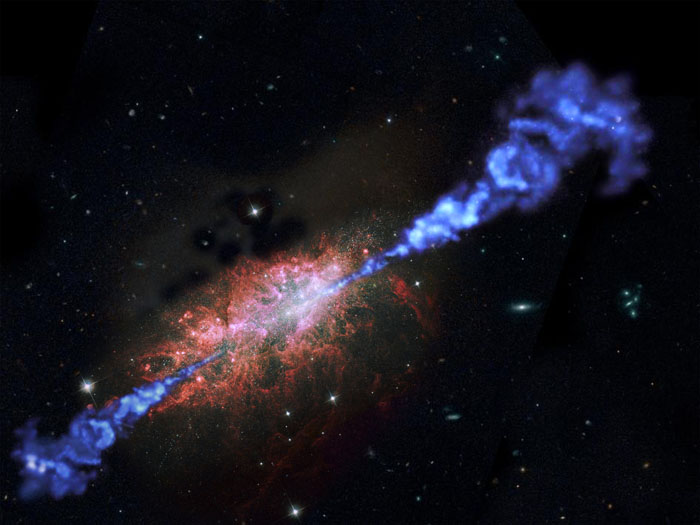Fireworks in the early universe

Galaxies in the early universe grew fast by rapidly making new stars. Such prodigious star formation episodes, characterized by the intense radiation of the newborn stars, were often accompanied by fireworks in the form of energy bursts caused by the massive central black hole accretion in these galaxies. This discovery by a group of astronomers led by Peter Barthel of the Kapteyn Institute of the University of Groningen in the Netherlands is published today in the Astrophysical Journal Letters.
Our Milky Way galaxy forms stars at a slow, steady pace: on average one new star a year is born. Since the Milky Way contains about a hundred billion stars, the actual changes are very slight. The Milky Way is an extremely quiet galaxy; its central black hole is inactive, with only weak energy outbursts due to the occasional capture of a passing star or gas cloud.
Bright, exotic radiation
This is in marked contrast to the ‘active’ galaxies of which there are various types and which were abundant in the early universe. Quasars and radio galaxies are prime examples: owing to their bright, exotic radiation, these objects can be observed as far as the edge of the observable universe. The light of the normal stars in their galaxies is extremely faint at such distances, but active galaxies can be easily detected through their luminous radio, ultraviolet or X-ray radiation, which results from steady accretion onto their massive central black holes.
Peculiar exotic objects
Until recently these distant active galaxies were only interesting in their own right as peculiar exotic objects. Little was known about the composition of their galaxies, or their relationship to the normal galaxy population. However, in 2009 ESA's Herschel space telescope was launched. Herschel is considerably larger than NASA's Hubble, and operates at far-infrared wavelengths. This enables Herschel to detect heat radiation generated by the processes involved in the formation of stars and planets at a small scale, and of complete galaxies at a large scale.
Initial inspection
Peter Barthel has been involved with Herschel since 1997 and heads an observational programme targeting distant quasars and radio galaxies. His team used the Herschel cameras to observe seventy of these objects. Initial inspection of the observations has revealed that many emit bright far-infrared radiation.
The Astrophysical Journal Letter ‘Extreme host galaxy growth in powerful early-epoch radio galaxies’, by Peter Barthel and co-authors Martin Haas (Bochum University, GER), Christian Leipski (Max-Planck Institute for Astronomy, Heidelberg, GER) and Belinda Wilkes (Harvard-Smithsonian Center for Astrophysics, Cambridge, USA), describes their project and the detailed analysis of the first three distant radio galaxies.
Simultaneous grow
The fact that these three objects, as well as many others from the observational sample, emit strong far-infrared radiation indicates that vigorous star formation is taking place in their galaxies, creating hundreds of stars per year during one or more episodes lasting millions of years. The bright radio emission implies strong, simultaneous black hole accretion. This means that while the black holes in the centres of the galaxies are growing (as a consequence of the accretion), the host galaxies are also growing rapidly.
The Herschel observations thereby provide an explanation for the observation that more massive galaxies have more massive black holes. Astronomers have observed this scaling relationship since the 1990s: the fireworks in the early universe could well be responsible for this relationship.
Barthel: ‘It is becoming clear that active galaxies are not only among the largest, most distant, most powerful and most spectacular objects in the universe, but also among the most important objects; many if not all massive normal galaxies must also have gone through similar phases of simultaneous black hole-driven activity and star formation.’
Contact: Prof. Peter Barthel, tel. +31-6-11391826
The Astrophysical Journal Letters, Volume 757, Number 2
Extreme Host Galaxy Growth in Powerful Early-epoch Radio Galaxies
Peter Barthel, Martin Haas, Christian Leipski, and Belinda Wilkes
doi:10.1088/2041-8205/757/2/L26
More news
-
19 December 2025
Mariano Méndez receives Argentine RAÍCES award
-
18 December 2025
Why innovate, and for whom?
-
17 December 2025
Ben Feringa wins Feynman Prize
